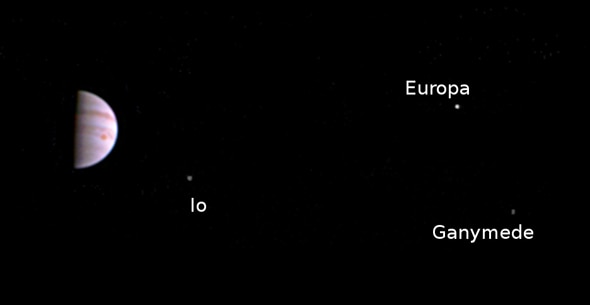Create a free profile to get unlimited access to exclusive videos, sweepstakes, and more!
Juno’s First Light

This is pretty neat: The image above is the first one taken of Jupiter and its moons by the Juno spacecraft after achieving orbit last week*. This was taken on July 10, 2016, when the Juno was a little over four million kilometers from the giant planet.
In the shot you can see Jupiter in a way we can’t from Earth: half full. Jupiter is five times farther away from the Sun than Earth is, so when we look at it from our planet we’re always seeing it more or less full. Even when we’re off to one side in our own orbit, seeing Jupiter from an angle, that angle is so small that Jupiter always looks essentially full to us.
But once you get far from the Sun, the geometry changes. Juno approached Jupiter “from the side”, catching up to it in its orbit around the Sun. It then entered into a polar orbit around the planet, on a path that will take it over the poles of Jupiter. The first two orbits are very long and elliptical, and then it’ll fire its engine again (in October) to drop it down closer.
After it burned its engine for an astonishing 35 minutes Juno was on almost exactly the orbit planned. It dipped low over Jupiter, then started moving away. The image above was snapped on the outbound leg of that first orbit, less than a week into the 53.5-day journey around the planet.
Seeing Jupiter half full is pretty amazing to a seasoned astronomer like me. I’ve observed the planet hundreds of times through binoculars and telescopes, and this view of it is nothing less than jaw-dropping.
You can see some details in the clouds too, like two of the main dark belts (the reddish-brown bands) and lighter colored zones. The Great Red Spot shows itself too, that ridiculously huge storm that’s been around for centuries, and could easily swallow a few Earth’s without a hiccup.
Three of Jupiter’s four large moons are in the shot as well (Callisto, which orbits pretty far out, isn’t seen). Juno’s mission is focused on the planet, not the moons, so we won’t see any close-ups of them, though we’ll get more scenes like this in the future.
But just you wait. Juno’s orbit will take it as far as 2.7 million km from Jupiter at apojove† (the point in its orbit farthest from the planet), then it will dive to a stunning 4,000 km above the cloud tops, screaming past the planet at nearly 60 kilometers per second, roughly 200,000 kilometers per hour! At that speed, it could get from the Earth to the Moon in two hours.
The point being, when Juno is close to Jupiter, it’s close. The images we’ll get from it will be staggering. They won’t come for a while yet, so be patient. I know they’ll be worth the wait.
* The very first image taken by a new telescope or detector is called “first light”, which I think is quite poetic and lovely. While technically this isn’t the first taken by Juno (we got a nice animation taken while on approach), it’s the first taken from orbit, so that counts.
†Correction, July 13, 2016: I originally wrote "perijove" here (which is the closet point in its orbit to Jupiter) rather than "apojove". My apologies for any confusion.


























